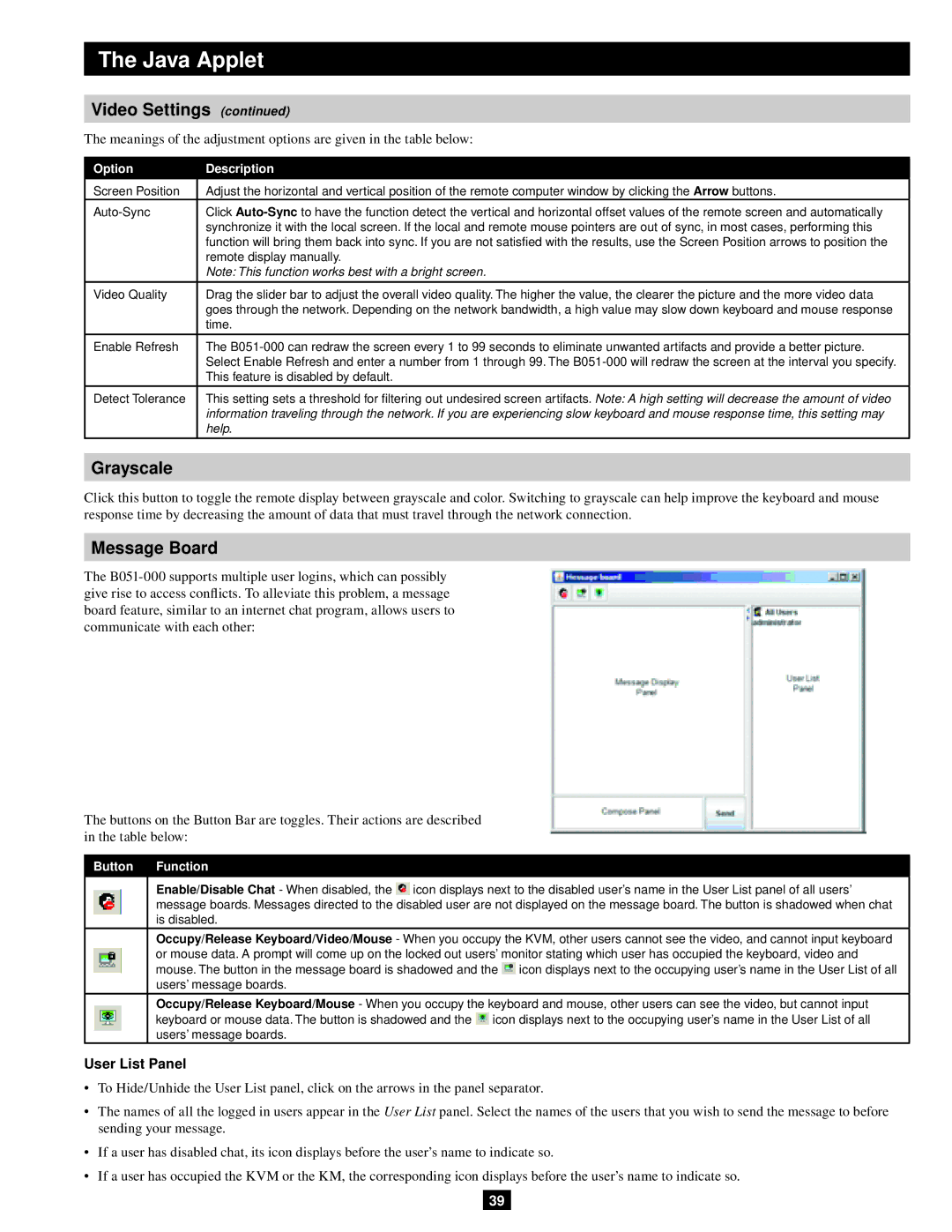
The Java Applet
Video Settings (continued)
The meanings of the adjustment options are given in the table below:
Option | Description |
Screen Position | Adjust the horizontal and vertical position of the remote computer window by clicking the Arrow buttons. |
Click | |
| synchronize it with the local screen. If the local and remote mouse pointers are out of sync, in most cases, performing this |
| function will bring them back into sync. If you are not satisfied with the results, use the Screen Position arrows to position the |
| remote display manually. |
| Note: This function works best with a bright screen. |
|
|
Video Quality | Drag the slider bar to adjust the overall video quality. The higher the value, the clearer the picture and the more video data |
| goes through the network. Depending on the network bandwidth, a high value may slow down keyboard and mouse response |
| time. |
|
|
Enable Refresh | The |
| Select Enable Refresh and enter a number from 1 through 99. The |
| This feature is disabled by default. |
Detect Tolerance | This setting sets a threshold for filtering out undesired screen artifacts. Note: A high setting will decrease the amount of video |
| information traveling through the network. If you are experiencing slow keyboard and mouse response time, this setting may |
| help. |
|
|
Grayscale
Click this button to toggle the remote display between grayscale and color. Switching to grayscale can help improve the keyboard and mouse response time by decreasing the amount of data that must travel through the network connection.
Message Board
The
The buttons on the Button Bar are toggles. Their actions are described in the table below:
Button Function
Enable/Disable Chat - When disabled, the ![]() icon displays next to the disabled user’s name in the User List panel of all users’ message boards. Messages directed to the disabled user are not displayed on the message board. The button is shadowed when chat is disabled.
icon displays next to the disabled user’s name in the User List panel of all users’ message boards. Messages directed to the disabled user are not displayed on the message board. The button is shadowed when chat is disabled.
Occupy/Release Keyboard/Video/Mouse - When you occupy the KVM, other users cannot see the video, and cannot input keyboard or mouse data. A prompt will come up on the locked out users’ monitor stating which user has occupied the keyboard, video and mouse. The button in the message board is shadowed and the ![]() icon displays next to the occupying user’s name in the User List of all users’ message boards.
icon displays next to the occupying user’s name in the User List of all users’ message boards.
Occupy/Release Keyboard/Mouse - When you occupy the keyboard and mouse, other users can see the video, but cannot input keyboard or mouse data. The button is shadowed and the ![]() icon displays next to the occupying user’s name in the User List of all users’ message boards.
icon displays next to the occupying user’s name in the User List of all users’ message boards.
User List Panel
•To Hide/Unhide the User List panel, click on the arrows in the panel separator.
•The names of all the logged in users appear in the User List panel. Select the names of the users that you wish to send the message to before sending your message.
•If a user has disabled chat, its icon displays before the user’s name to indicate so.
•If a user has occupied the KVM or the KM, the corresponding icon displays before the user’s name to indicate so.
39
